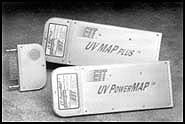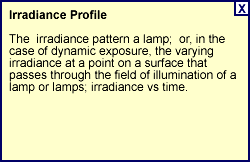Guide to UV Measurement
Profiling Radiometers
A profiling radiometer, in addition to measuring joules and watts as does a radiometer, generates an irradiance profile which is a plot of the irradiance as a function of time. These are sometimes referred to as Mapping Radiometers.
"Mapping" or “Profiling” Radiometers are sampling radiometers with on-board memory. After a test exposure, the instrument provides the entire exposure profile. Instruments are currently available that provide this information on either a small LCD display on the instrument or transfer the information to a computer for viewing and analysis. Files transferred to a computer can be shared via email. Earlier models that are still supported provided the irradiance profiles on thermal paper.
Single-band and multiple-band instruments are available. Since these record the "history" of a pass under lamps, they can provide data on the irradiance profile of each lamp in rows of lamps. Relating the time scale to distance requires only the knowledge of the precise speed of the measurement.
 |
 |
View a chart of Multiple Lamps with Profiling Radiometers
Profiling radiometers offer the following advantages:
- The way the UV is delivered (focus) to the cure surface can be checked and adjusted for each UV system. The profiling radiometer identifies when a system or bulb has changed position in relationship to the cure surface or reflector. Changes in the focus can happen after maintenance or with changes in the system over time. In some applications, the specified process parameters (focused, defocused) can be verified and set as needed.
- Some profiling radiometers allow you to save the irradiance profiles as a file or in the unit for comparison of the line over time. An irradiance profile saved when the line is performing well can be compared to an irradiance profile when the line is having problems. This feature allows you to quickly determine if the UV output has changed or if there is something else in your process to target to get your line back up and running.
- Many formulators like to collect line ‘profiles' when a line is up and running with their product. When the call comes in to their technical services group that their product is no longer ‘curing', they have the ability to compare UV profiles from when things were working to when things have stopped working. Very quickly, the formulator can narrow down and focus their efforts of whether it is a ‘formulation' issue or an ‘equipment' issue.
- Valuable production time does not have to be wasted waiting for individual systems to warm-up when you use a profiling radiometer The peaks from each UV system on the irradiance profile can be scanned very quickly to identify the system(s) that are not performing as expected. Maintenance can be targeted and specific to individual systems that fall below the threshold that you set.
- Some profiling radiometers allow you to break down with your computer the individual joule and watt output from each system. This individual breakdown can be quickly done in an office setting instead of waiting for lamps to warm up out on the production floor.
- View a chart of Multiple Lamps Profile Individual Breakdown
- Link to the UV Systems with Multiple Lamps page
- View a chart of Multiple Lamps with Numbers
Users most often think of using Profiling Radiometers on UV systems with conveyors. This is a common use for profiling radiometers but their versatility also allows for their use on other applications. Use your imagination for your application.
Some examples of their use other than on conveyors:
- Profiling radiometers have been used for static measurements or where the UV system moves over the instrument. If the profiling radiometer unit is placed under a lamp system while it warms up, important information can be gathered on how the UV system powers up and stabilizes.
- Profiling radiometers have been used under digital UV ink jet applications with the UV source making several passes over a static instrument. The uniformity of each UV pass can be checked.
- Profiling radiometers have been inserted into flood/small part fixtures to measure the UV arriving at a part.
- Profiling radiometers have been used with X-Y-Z controllers to carefully ‘map' the distribution of UV arriving at a cure surface at multiple points under the lamp housing. Equipment manufacturers can use this data to make decisions about reflector shapes, materials and how the distance to the cure surface changes the pattern of arriving UV.
- Faster sampling (2048 Hz) radiometers can provide information on the cycling of power supplies. This is has also a useful tool for equipment manufacturers.
Multi-Band Profiling Radiometers:
Multi-band profiling radiometers have all the advantages of the profiling radiometers that are described above. Instead of having just one spectral response, multi-band radiometers measure in multiple areas of the UV spectrum. Up to four spectral response areas (UVA, UVB, UVC, UVV-near visible) are available on current multi-band profiling radiometers. Comparing the four different response areas allows the user to easily and quickly identify different types of bulbs. In a large production line with many UV systems and different bulb types, this check can confirm that the proper bulb has been installed in the correct location on the line. view the chart Mercury to Mercury-Gallium Comparison UVA_UVV.
